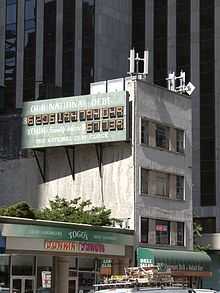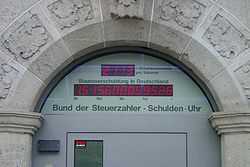National Debt Clock
Coordinates: 40°45′23″N 73°59′02″W / 40.756329°N 73.983921°W
The National Debt Clock is a billboard-sized running total display which constantly updates to show the current United States gross national debt and each American family's share of the debt. It is currently installed on Sixth Avenue in Manhattan, New York City. It was the first debt clock installed.
The idea for the clock came from New York real estate developer Seymour Durst, who wanted to highlight the rising national debt. In 1989, he sponsored the installation of the first clock, which was originally placed on Sixth Avenue—between 42nd Street and 43rd Street—one block away from Times Square. At the time, the national debt remained under $3 trillion but was rising. The clock was temporarily switched off from 2000 to 2002 due to the debt actually falling during that period.
In 2004, the original clock was dismantled and replaced by the current clock at the new location one block away. In 2008, the U.S. national debt exceeded $10 trillion for the first time, leading to press reports that the clock had run out of digits.[1][2][3][4]
The original clock outlived Seymour, who died in 1995, with Seymour's son Douglas taking over responsibility for the clock through the Durst Organization. As of September 2009, Douglas Durst's cousin Jonathan "Jody" Durst, with whom he currently shares a co-presidency of the company, is in the process of taking over the day-to-day operations as president. In an interview with The New York Times, Jonathan Durst has said that maintenance of the clock is planned "for years to come."[5]
History
Invented and sponsored by New York real estate developer Seymour Durst, the National Debt Clock was installed in 1989.[6] After Seymour's death in 1995, his son Douglas Durst became president of the Durst Organization, which owns and maintains the clock.[7][8][9]
Douglas Durst has stated that the clock represents a non-partisan effort and explained the motivation behind the project in terms of intergenerational equity: "We're a family business. We think generationally, and we don't want to see the next generation crippled by this burden."[10] According to Douglas, his father had been toying with the basic idea of drawing attention to the growing national debt since at least 1980, when during the holiday season he sent cards that said "Happy New Year. Your share of the national debt is $35,000" to senators and congressmen.[11] In the early eighties, when Seymour first developed the idea of a constantly updated clock, the technology required to implement the project was not yet available.[10]
First clock

With the national debt at US$2.7 trillion dollars, the original 11 by 26 feet (3.4 m × 7.9 m) clock was constructed in 1989 at a cost of US$100,000.[7] It was mounted a block from Times Square, on a Durst building at Sixth Avenue near 42nd Street, facing the north side of 42nd Street and Bryant Park across the intersection. Built by the New York sign company Artkraft Strauss, the clock featured a dot-based segment display emulating the then-typical character resolution of 5x7. Similar to the second clock, the updating mechanism was such that the display was set to the estimated speed of debt growth (odometer-style) and adjusted weekly according to the latest numbers published by the United States Treasury.[7][9][12] Up until the week before his death, Seymour Durst himself adjusted the tally via modem.[7] Since his passing, Artkraft Strauss has been keeping the figures current.[7]
In 2000, due to an improving debt situation, the clock started to run backward.[8] With the original purpose of the clock being to highlight the rising debt and the reverse giving a mixed message, and with the display not being designed to properly run backward, the clock was unplugged and covered with a red, white and blue curtain in September 2000, with the national debt standing at roughly 5.7 trillion dollars.[10] The clock was not dismantled, however, and in July 2002 the curtain was raised and the clock once again picked up tracking a rising debt, starting at 6.1 trillion dollars.[13]
Second clock
In 2004, the original clock was moved from its location near 42nd Street; the building has since made way for One Bryant Park. An updated model, which can run backward, was installed one block away on a Durst building at 1133 Avenue of the Americas (more commonly known as 1133 Sixth Avenue).[10][14] It is mounted on the side wall of the building which faces W. 44th Street. The new clock is outfitted with a brighter seven-segment display with multiple LEDs per segment, allowing the numbers to be read more easily.
In the midst of extensive media attention during the financial crisis beginning in 2007, some news reports mentioned the National Debt Clock, highlighting the fact that its display had run out of digits when the U.S. gross federal debt rose above US$10 trillion on September 30, 2008.[1][2][3][4]
An overhaul or complete replacement adding two more digits to the clock's display is currently being planned.[12][15][16]
Similar projects

The idea of conveying a message through a periodically updated clock found an earlier expression in the Doomsday Clock. However, the innovation of the National Debt Clock was to feature a constantly running counter; it has since inspired similar projects elsewhere, both in the United States and further afield.[7][17] Various tracking counters of national debt are also kept online.[18]
The National Debt Clock has also been credited as the inspiration behind other running totalisers, for example an AMD campaign employing an electronic billboard; instead of a debt, it tracked the supposed additional cost of using a rival chip.[19]
Two displays related to the national debt were shown during the 2012 Republican National Convention. One of the displays showed a ticking number similar to The National Debt Clock. The second display showed a number estimating the amount the national debt had increased since the start of the convention.[20]
See also
- Government debt
- United States public debt
- History of the U.S. public debt
- Maxed Out, a 2006 documentary in which the clock is featured[21]
References
- ↑ 1.0 1.1 "National Debt Clock runs out of digits". London: timesonline.co.uk. October 9, 2008. Retrieved 2008-10-10.
- ↑ 2.0 2.1 "The Debt to the Penny and Who Holds It — Daily History Search Application". TreasuryDirect. September 30, 2008. Retrieved September 15, 2009.
- ↑ 3.0 3.1 "Debt clock can't keep up (CNN video)". cnn.com. October 4, 2008. Retrieved 2008-10-05.
- ↑ 4.0 4.1 "US debt clock runs out of digits". BBC News. October 9, 2008.
- ↑ Marino, Vivian (September 11, 2009). "Square Feet | The 30-Minute Interview: Jonathan Durst". The New York Times. Retrieved September 15, 2009.
- ↑ Daniels, Lee A. (November 8, 1991). "Chronicle". The New York Times. Retrieved 2008-10-06.
- ↑ 7.0 7.1 7.2 7.3 7.4 7.5 Toy, Vivian S. (May 28, 1995). "The Clockmaker Died, but Not the Debt". The New York Times. Retrieved 2008-10-06.
- ↑ 8.0 8.1 "National Debt Clock stops, despite trillions of dollars of red ink". CNN, AP, Reuters (hosted on Internet Archive's Wayback Machine). September 7, 2000. Archived from the original on 2008-01-29. Retrieved 2008-10-05.
- ↑ 9.0 9.1 Upham, Ben (May 14, 2000). "NEIGHBORHOOD REPORT: TIMES SQUARE; Debt Clock, Calculating Since '89, Is Retiring Before the Debt Does". The New York Times. Retrieved 2008-10-05.
- ↑ 10.0 10.1 10.2 10.3 "US debt clock running out of time, space". China Daily / AFP. 2006-03-30. Retrieved 2008-10-05.
- ↑ Koh, Eun Lee (August 13, 2000). "FOLLOWING UP; Time's Hands Go Back On National Debt Clock". The New York Times. Retrieved 2008-10-06.
- ↑ 12.0 12.1 Rubinstein, Dana (October 6, 2008). "Durst To Add Extra Trillion Dollar Digit to National Debt Clock". observer.com. Retrieved 2008-10-08.
- ↑ Stevenson, Robert W. (July 13, 2002). "White House Says It Expects Deficit to Hit $165 Billion". The New York Times. Retrieved 2008-10-06.
- ↑ Haberman, Clyde (March 24, 2006). "We Will Bury You, in Debt". The New York Times. Retrieved 2008-10-06.
- ↑ Boniello, Kathianne (October 5, 2008). "'1' Big Tick is due for Debt Clock". nypost.com. Retrieved 2008-10-08.
- ↑ "U.S. debt too big for National Debt Clock (MSNBC video)". NBC Nightly News. msnbc.com. October 7, 2008. Retrieved 2008-10-08.
- ↑ "Debt Clock Moves Next Door to Government". Deutsche Welle. June 18, 2004. Retrieved 2008-10-05.
- ↑ Examples for online debt tracking resources include treasurydirect.gov, brillig.com and others, see External links below.
- ↑ Hesseldahl, Arik (May 3, 2006). "AMD Sticks It to Intel—Again". BusinessWeek.com. Retrieved October 27, 2009.
- ↑ "As Convnetion Opens, Debt Clock Ticks". New York Times. August 27, 2012. Retrieved August 28, 2012.
- ↑ "indieWIRE INTERVIEW: James Scurlock, director of "Maxed Out"". indieWIRE. March 11, 2007. Retrieved 2008-10-10.
External links
| Wikimedia Commons has media related to US National Debt Clock. |
- treasurydirect.gov — U.S. public debt on TreasuryDirect, a website maintained by the United States Treasury
- National Debt in Real Time